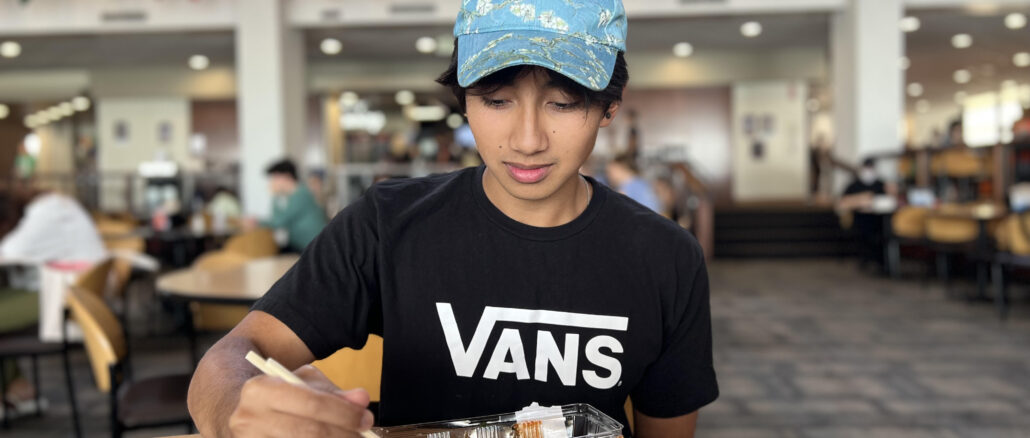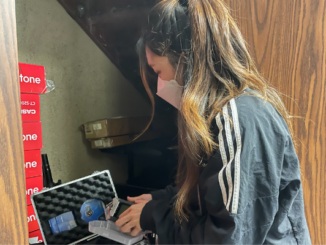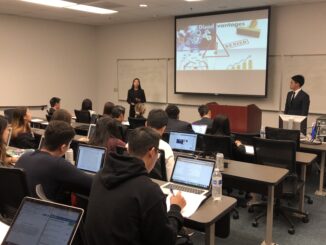
Athena Chuang, a first-year business administration major of Taiwanese background, had high hopes for the boba in the Lighthouse Cafe.
Until she tasted it.
“So the boba was really hard and it’s just not how it’s supposed to be,” Chuang said. “I feel like they are gaslighting my culture.”Pepperdine’s new food caterer, Bon Appetit, offers several ethnic cuisines, including Taiwanese, Mexican, Japanese, Korean and more. Taiwanese drinks are offered in the Lighthouse, while the Waves Cafe and food trucks offer food from different cultures. However, students from these
cultures said they feel let down by how poorly the new caterer represents their cuisines. Students are left dissatisfied after trying the version of their ethnic dish that Pepperdine offers.
Five students from different ethnic backgrounds expressed their opinions on Pepperdine’s cultural food and how it makes them doubt the cafeteria’s true intentions of offering diverse cuisines.
The Lighthouse Boba
Boba in the Lighthouse is a new addition to campus.
Chuang, a Taiwanese international student, said she was excited to see that her native drink was available. Unfortunately, her excitement dissipated upon tasting it.
She said the boba and the tea flavors were poorly made and tasted bad.
“I honestly don’t want people to try it because of how bad it is,” Chuang said.
John Leone, resident district manager for Bon Appetit, said their team came up with having boba on campus.
“Boba is pretty on trend right now, so we thought it would be fun to come up with different flavors and different ideas of boba,” Leone said.
Bon Appetit uses a boba manufacturer that is a new addition to their company.
Chuang said she has seen Bon Appetit offer many Asian cultural cuisines. She has tried several Asian fusion dishes in the cafeteria but said they were all bad.
“I think they try their best, but it feels like they’re just doing it for the sake of doing it,” Chuang said.
Leone said student voices are essential to changing and improving the boba.
“Through feedback, it would be great to get some more ideas, maybe from perhaps students and staff, and faculty and change up the flavors,” Leone said.
Food in the Waves Cafe
Ivan Manriquez-Mercado, a junior political science and Hispanic studies double major who is of Mexican heritage, thinks Mexican food in the Waves Cafe lacks authenticity.
The tortillas used for tacos were hard, like a tostada, when soft tacos are the norm, Manriques-Mercado said.
“It just felt rushed, and even down to the tortillas they used it wasn’t it,” Manriquez-Mercado said.
Faith Oak, a senior communication major who is Korean, was initially excited Bon Appetit was offering several Korean dishes. However, she read the descriptions, and while they consisted of Korean spices and flavors, she said it was not accurate at all.
“The ingredients are similar, but it’s not actually the same flavor, so it feels like a completely different dish,” Oak said.
She ordered a Korean rice plate with gochujang and bulgogi, but it appeared to be entirely different.
“It would be steak and sriracha or other spicy sauce, so it felt like it was a taco plate or something,” Oak said.
She wonders what other students may think of Korean food given the inaccuracy of what they are tasting.
“In the back of my mind I’m like, ‘Oh, I wonder if people think this is what actual Korean food is like,’ and I’m like, ‘I hope they don’t,’” Oak said. “I think all of it kind of tastes like a fusion of each other so it’s not really any specific culture that’s being accurately represented. I think it’s all just kind of one big jumble.”
One food the cafeteria consistently offers is sushi.
“To be honest I was pretty disappointed in the accuracy of the cafe’s rendition of sushi,” said Taha Sikder, a sophomore psychology major who is half Japanese and half Bengali. “But I wasn’t ultimately surprised since I knew it wasn’t gonna be as authentic as getting it somewhere else.”
For him, the inauthentic sushi does not lead him to believe other students will change their opinions on Japanese food.
“Sushi is more widely found that they [students] would know what a more authentic version would taste like,” Sikder said.
The Food Trucks
Christabel Tanu, a sophomore psychology major and international student from Indonesia, was very surprised to see an Indonesian food truck at Pepperdine this semester. Indonesian food is not well known in the States.
She ordered fried noodles, but the representation was not what she is used to.
“I don’t think it’s that accurate,” Tanu said. “They don’t have the flavor or spices that I would usually have on the fried noodles. But overall it’s still a good quality of fried noodles.”
Tanu said she is trying to get used to eating American dishes served in the Waves Cafe as the only opportunity she has had to eat Indonesian food was the one food truck.
“They mostly serve entrees like chicken, beef and all the foods that Americans eat,” Tanu said.
This semester the food trucks were on campus for the first week of school and have not been around after.
Tanu said this left her feeling sad since the cafeteria does not serve Indonesian food.
Student perspective on the cafeteria’s efforts at diversity
Eating food from one’s culture helps to preserve memories by allowing the individual to stay connected to their culture, Katherine E. Wright wrote in a Feb. 25 Ecology of Food and Nutrition research article.
The lack of authenticity in Pepperdine’s ethnic food causes students to question the motives of the university and whether they really care about diversity and inclusion.
“They didn’t make the time to find chefs that can properly represent different ethnicities,” Manriquez-Mercado said. “I understand Bon Appetit, the caterer, wants to appreciate a variety of cultures, but it definitely becomes appropriation when you taste it and it’s not giving what it’s supposed to give.”
Communication Professor Charles Choi, who teaches intercultural communication classes, said it can be difficult to differentiate cultural appreciation from appropriation. He emphasized the importance of a person’s intent that comes from their heart.
“The heart is a big factor there,” Choi said. “I think if someone is willing to do that homework and consider and to carefully be mindful about that or at least take pause. I think that goes a long way and avoids a lot of misunderstanding.”
Choi, who is of Korean ethnicity, said he has tried several ethnic dishes in the cafeteria a few times.
“I think the cafeteria is doing a great job,” Choi said. “I think Pepperdine is very careful from the top down to be conscious about cultural appreciation throughout the university. Room for criticism definitely. Room for conversation absolutely.”
Choi said he appreciates the cafeteria’s effort to provide ethnic dishes.
“I’ve had some food in the cafeteria already,” Choi said. “One dish I had once was a Moroccan chicken dish. Not quite exactly what I experienced in Morocco personally, but man I was like, ‘OK, they’re going for it, they’re giving it a shot here.’”
Tanu said the cafeteria has improved a lot from last year’s caterer.
“I think they’re doing great right now if you compare it to last semester,” Tanu said. “They have more Asian foods; udon, fried rice, and other stuff so I think they’re improving.”
Bon Appetit caters to a diverse population through student feedback
Bon Appetit works to provide different types of ethnic foods on rotation and to achieve this goal they listen to student concerns, Leone said.
“I think catering to the diverse population is we embrace feedback and that’s kinda how we get ideas and change menus and things like that,” Leone said.
In terms of providing ethnic dishes, Leone said his team consists of talented chefs, and it is fun to see what they can come up with.
Leone said the cafeteria layout is conducive to providing a proper variety of ethnic foods.
“You have sushi, you have pizza, you have a show and tell, so it kinda opens up the way the cafe is set up,” Leone said. “Kind of opens us up to creating menus that are diverse and ethnic.”
Seeking food elsewhere
Students who are dissatisfied with their ethnic food at Pepperdine tend to seek food elsewhere.
“Yeah, that’s why I have to go out to LA to eat actual Taiwanese food and get actual boba,” Chuang said. “I brought Taiwanese snacks here because I can’t get them at the caf.”
Oak similarly will never visit the cafeteria whenever she craves Korean food.
“If I actually want Korean food then I’ll go off campus or try to cook at home,” Oak said. “Even though I’m not the best cook, I think it’s better for me to cook at home than to try the caf.”
Tanu purchases her own ingredients to make Indonesian noodles in her dorm. She even bought an electric pot.
“I cook more at my dorm, especially with my electric pot with Indomie. It’s an Indonesian instant noodle,” Tanu said. “I cook that often. I think this month maybe I cooked for like five or six times.”
It’s common for homesick international participants to cook their ethnic foods, Debra A. McLachlan and Jessica Justice found in a 2009 study, A Grounded Theory of International Student Well-being.
Both international students, Chuang and Tanu, are homesick.
Chuang and Tanu said they miss the authentic spices and ingredients from their countries.
“Back home I would usually eat rice and side dishes and it’s something that I’m used to,” Tanu said. “So being here I have to get used to eating meat and vegetables, which is something that is uncommon for me so I get homesick.”
China Poblete reported this enterprise story in Jour 241 during the Fall 2022 semester under the supervision of Dr. Christina Littlefield and Dr. Theresa de los Santos. Dr. Littlefield supervised the web article.




